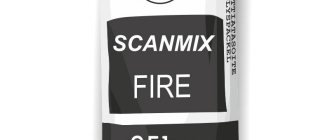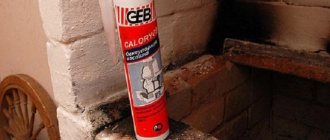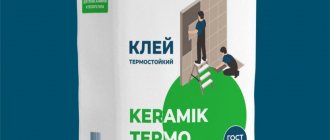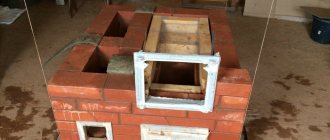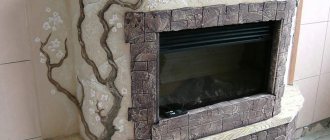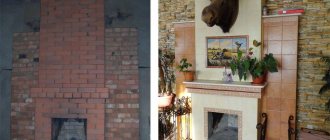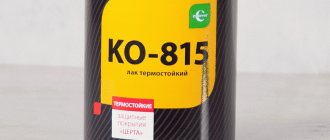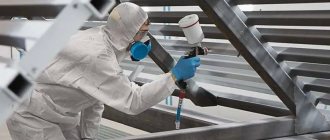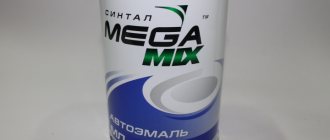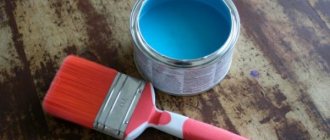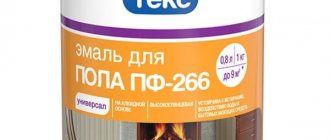Varnish for stoves and fireplaces made of brickwork must be of high quality, resistant to high temperatures, and it must create a stable coating on the surface of the structure. No matter how strange it may seem, in the modern world, heating a home with stoves is becoming increasingly popular. The use of fireplaces is not only beautiful and unusual from an aesthetic point of view, but also makes it possible to save money spent on utility bills during the cold period.
If the brickwork is done correctly, then there is no point in masking the structure under the facing coating. On the contrary, the beauty and authenticity of the structure should be emphasized by using the right coating. Below we will tell you in more detail about the best varnish to coat a brick oven and the method of applying it.
Lacquered red brick stove
Scope of application
Heat-resistant varnish for stoves is used not only on brick structures, but also on other materials that can be used as a finishing coating. Thus, the compositions are compatible with the following facing elements:
- Natural or artificial stone.
- Facing brick, clinker.
- Metal surfaces.
- Plaster.
- Tile and expanded clay tiles.
The compositions are also used for painting steam pipes, car exhaust pipes, and individual connections of internal combustion engines. Practice shows that they have proven themselves to be excellent both on stone and metal surfaces, as well as on glass.
A can of heat-resistant aerosol varnish Source gidkaminoff.ru
How to paint stoves
The application of heat-resistant varnish has a lot of subtleties, so many owners of private houses leave such work to professionals. If you wish, you can carry out all the preparatory work yourself. First of all, it is necessary to thoroughly clean the surface of the oven from any contaminants.
If the work is carried out manually, it is best to use a metal brush, as well as a soap solution, which allows you to remove not only dust, but also deep dirt.
If there are deep oily stains on the surface of the brickwork, you can use aggressive cleaning agents, but then be sure to rinse the brickwork thoroughly with clean water.
Thorough pre-cleaning is only the first stage in preparing the surface for application of a primer or special impregnation. For most types of paints and varnishes that are resistant to elevated temperatures, the application of special primers and impregnations is very important. These substances allow you to create excellent adhesion between the brick oven and the varnish. Without applying special compounds, the varnish may soon begin to peel off.
Features of the composition
The heat-resistant varnish includes a voluminous list of modified silicone resins, the structure of which is based on several organic solvents. The main purpose for which it is applied is to refine and protect the surface of stove or fireplace bricks and facing materials exposed to thermal effects. Painting is carried out in several layers, the number of which depends on the absorbent qualities of the surface being treated.
Glossy lacquered surface Source ochg.ru
The main performance characteristics of stove varnish are the following factors:
- High temperature resistance. The composition is immune to short-term exposure to open fire and prolonged thermal exposure. Industrial heat-resistant varnish is able to withstand high temperatures up to 1,800°C; in everyday life, compositions with lower temperature characteristics are used, since there is no need to heat the surface to such temperatures.
- Forms a surface that does not absorb moisture.
- Forms a protective film on the surface that prevents cracks.
- It dries quickly, which allows it to be used for treating home stoves and fireplaces.
- Safe from an environmental point of view. The composition itself has a sharp, specific odor, but disappears after drying.
Healthy! The intermediate drying time of oven heat-resistant varnish is no more than 1 hour. This allows you to apply and completely dry the required number of layers in 1 day.
Work process
How to apply varnish correctly, what rules to follow?
- First of all, prepare the necessary tool of your choice:
- flat brushes;
- sprayer with a nozzle size of 1.8 - 2.5 millimeters; the distance from the sprayer to the oven surface should be at least 20-30 cm;
- roller
- Then prepare the surface for painting:
- fill cracks and chips;
- remove dirt and dust from the oven;
- dry the surface;
- degrease it using solvent.
- Apply varnish. As a rule, it is recommended to apply three coats to a brick surface. Because thanks to its structure, brick is able to absorb varnish. The first is applied directly on top of the stove brick; it will fill uneven areas. The second one enhances the protective properties and smoothes the surface. The third one improves the aesthetic appearance of the stove. If you apply two or more layers of varnish, the surface of the stove will become glossy-matte.
What you need to know when applying
There are a number of factors to consider before painting with heat-resistant varnish. The most significant are the following:
- According to the manufacturer's instructions, the composition can be worked at temperatures ranging from -40°C to +40°C. However, they also recommend painting at +15C - +20°C.
- Before starting work, the composition must be mixed to a homogeneous consistency.
- Painting is performed only on cleaned, dried and primed surfaces.
No. 4. Criteria for choosing paintwork materials
The choice of the most suitable coating composition depends on the place of its application. When working with external walls, building facades and street structures (gazebos, fences), it is necessary to give preference to products with an increased level of moisture protection and resistance to UV rays. Also, such varnishes should look impressive on brickwork without losing their decorative functions during seasonal rainfall.
Other requirements are put forward for compositions for fireplaces and stoves:
- No toxicity. The varnish should not have an unpleasant odor, since when heated, dangerous toxins can be released.
- Heat resistance. For coatings of fireplace structures, only specialized compounds that are fire-resistant should be used.
To cover interior brick walls, it is better to give preference to acrylic or silicone compounds. The choice of such varnishes is large enough to choose the most profitable option.
Types of heat-resistant paints and varnishes
To paint a surface subject to thermal loads, one of the compositions can be used, which we will discuss below.
Varnish KO-85 and KO-815
Heat-resistant oven varnish is based on polyvinylsiloxane and polybutyl methacrylate resin. Composition of universal colorless type. Good heat-resistant properties allow it to be used on metal and brick surfaces.
Stove varnish in an aerosol can Source stroimaterials.ru
Interesting! Heat-resistant varnish KO-85 is used as a modifier to reduce the drying time of alkyd and acrylic mixtures. It is used in the production of heat-resistant cold hardening KO-814.
Briefly about the main thing
Building a brick stove in a house or country house is far from the final stage in decorating a room. The stove structure also needs to be coated with paint.
Before decorating the structure with paints and varnishes, you should seal the cracks, treat the joints and clean up the irregularities. If you don’t figure out what paint to paint a brick stove with or don’t carry out additional surface treatment before painting, very soon the brick will begin to crumble.
The stove can be painted with polyurethane or silicone paint; the most budget-friendly method is ordinary lime whitewash.
It is important to follow the painting instructions: first treat hard-to-reach places and depressions with the composition, and only then apply the substance to the main area.
Ratings 0
In a can or in a jar – which option is better?
Depending on the packaging, heat-resistant paints can be of two types:
- aerosol paint in spray cans (volume up to 500 milliliters, extremely convenient to use);
liquid in cans of 1 kilogram, as well as in buckets of 20-30 kilograms.
It is quite obvious that aerosols are more popular, and the reason for this is the numerous advantages.
- During painting, the aerosol is evenly distributed over the surfaces being treated.
- It can never thicken, so it can be used even after a long time.
- The small size and lightness of the cans allow you to work with them even in the most difficult to reach places.
- In addition, the cans are easy to use; even those who have no experience in painting can handle painting.
- Finally, such paint does not require preliminary dilution, and working tools do not need to be washed after painting.
Lime and chalk
These two solutions are often practiced when the question arises: how to paint a brick oven.
The key word here is “brick”. The choice of coloring matter will also be appropriate. The paint must have good penetration. Further differences will affect the room in which the object is located. If in a bathhouse, then the relevance of moisture resistance and invulnerability to steam increases; if in a living room, beauty is important; in garages and industrial premises, strength is important. Stoves in garages and other non-residential premises are often subject to mechanical stress - accidental impacts from handling tools, etc. Accordingly, the paint layer must adhere as tightly as possible.
Perhaps these are the most ancient and life-tested methods.
- Advantages:
- financial inclusion;
- ease of preparation of the composition;
- ease of application;
- antifungal effect (in the presence of lime).
the need for multiple applications (otherwise the transparency of the top light layer against the background of the dark bottom layer is guaranteed);
Lime and chalk are absolutely not suitable for painting red brick stoves. In the absence of experience, it is quite difficult not to make a mistake with the consistency;
- zero moisture resistance (accordingly, such solutions are unacceptable for sauna stoves);
- Both lime and chalk are problematic to apply to old water-based layers. But applying the solution after plastering is an ideal option.
Useful tips from the experts
- Experts recommend:
- Focus on the thickness of thick kefir or liquid sour cream. This mixture will not spread during application;
- add 30-40 g of salt, previously dissolved in warm water. This will increase the strength of the applied mixture;
- Before starting work, if possible, remove old chalk and lime layers, thoroughly wet the base with water using a spray bottle or a wide soft brush;
- for painting, use brushes only with natural bristles, and in some cases you can use a foam roller or short-pile fur roller;
- Apply each subsequent layer on top of the previous one only after it has dried.
As for the number of layers, there should be 2-3 layers in total. Primary, main and fixing.
What are the reasons for working?
Can it be applied to brick, metal, enamel? As a rule, lime and chalk are used for painting brick substrates. For example, if you need to renovate a Russian stove in a residential building or a brick or stone structure in a country house.
Iron is sometimes also coated with lime (almost never with chalk), but the result quickly disappears - the coating literally comes off in patches within a few months after the work has been completed. It is best to work on iron substrates with special paints.
Neither lime nor chalk are categorically compatible with enameled bases - the applied solution is repelled by a too dense smooth base.
Factors that negatively affect paint
The main problem that arises when choosing a coating is the high surface temperature. Therefore, standard options for solving this issue are not suitable. Ordinary paints will not withstand use on metal heated to three hundred degrees; they will simply peel off or burn. But this is not the only thing you need to think about when choosing a composition. There are other conditions, namely:
- Any metal tends to expand as it heats up. The material for furnaces is selected in such a way that this indicator is minimal, but it is still impossible to reduce it to zero. Therefore, there is a significant risk of paint cracking during use.
- During its intended use, a considerable amount of steam is generated in the bathhouse. High humidity causes the coating to peel off, so this factor must be taken into account when choosing the type of paint.
General recommendations
- When choosing any paint, be wise:
- specify the composition and purpose (what can be used to paint a potbelly stove in a carpentry workshop may not be acceptable for an iron bathhouse or home brick stove);
- find out the availability of certificates (unfortunately, there are dubious products on the market made from ingredients that have not been tested for safety. Certificates largely eliminate this issue and inspire confidence in the manufacturer);
- do not forget to use the product correctly - prepare the base (clean it of dust, grease, debris) and apply the required number of layers.
Caution and rationalism in finding solutions will help you achieve your goal without harm to your health, beautifully paint your stove or fireplace, and protect the outside from damage.
Why do you need to paint?
The main task of paint is to protect the surface from rust. No matter how high-quality the material from which the sauna stove was made, the consequences of negative influences may appear over time. The hot water tank is most at risk of rust, and due to the fact that it forms from the inside, it is quite difficult to avoid.
The second reason why a sauna stove needs to be painted is the aesthetic component. An object made entirely of metal is difficult to fit harmoniously into the overall picture of the room. Some finished products are sold already painted, otherwise you will need to do it yourself.
